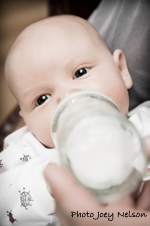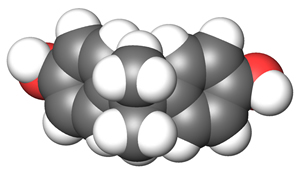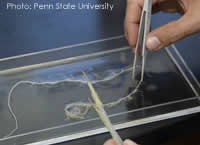14 October 2013 — Now that Klean Kanteen has released two fantastic insulated stainless steelcanisters (8 oz and 16 oz) with stainless steel lids, you can bring ice cream to work, guilt-free!… well almost… The insulated canisters will keep your food warm for about 4 hours and cold for up to 12 hours… that’s long enough for your favourite frozen desert to stay cool until snack time! Our guilty pleasure is the Vanilla Island Coconut Bliss, but of course, homemade is the best! Indulge!
Two ingredient cookie recipe…and container savings
We recently discovered a scrumptious oatmeal cookie recipe that requires only 2 ingredients: ripe bananas and oatmeal. No need for sugar, nor flour, just these 2 nutritious ingredients. We love it so much that we intend to make a huge batch of these cookies for close friends and family over the upcoming holidays, conveniently “wrapped” in one of our awesome stainless steel airtight containers. The container is part of the gift.
Wrap your presents without plastic tape – and do it in style
We have a number of new products in our line-up just in time for the holiday season, and this is one of our favorites: the sleek and elegant “On A Roll” Tape Dispenser created by London-based design duo black+blum. These cutting edge design gurus describe their product development ethic as “ruthless practicality with a mischievous and intellectually satisfying design aesthetic.”
Salad Without Plastic
We’ve not yet come across the right non-plastic salad spinner for our product line. There are sneaky ones out there touted as “stainless steel,” but that’s just on the exterior. The interior coming into contact with the greens is still plastic.
Our intrepid blogger friend, Beth Terry of My Plastic-Free Life, recently wrote a lovely blog about just this issue. She considers the traditional plastic ones we’ve likely all seen, and perhaps grown up with – but which are, yes, plastic. With some help from the indomitable Julia Child she discovers the traditional French and Swiss ones – some great options there!
Canadian Government Risk Assessment of Bisphenol A Leads to Proposal to Ban Polycarbonate Baby Bottles!
18 April 2008 — Canadian Government Risk Assessment of Bisphenol A Leads to Proposal to Ban Polycarbonate Baby Bottles!
A wonderful step forward for health and the environment! The Government of Canada announced today in Ottawa that a risk assessment of bisphenol A has been completed and has led the government to consider legally designating bisphenol A a ‘toxic’ substance hazardous to human health and the environment. This makes Canada the first jurisdiction in the world to begin taking tangible regulatory action against bisphenol A, which is the key chemical component in the plastic polycarbonate. Bisphenol A is used to make numerous common household items including many plastic baby bottles, reusable water bottles, large blue-coloured water storage bottles for water dispensers, and the lining of some food cans.
A new study links chemical Bisphenol A (BPA) to inability to form brain synapses
5 September 2008 — A new study links chemical Bisphenol A (BPA) to inability to form brain synapses. A new Canadian-US study found that BPA, the controversial chemical found in plastic bottles made of polycarbonate, may prevent the brain from building vital connections between neurons. This effect is in addition to imbalances to the reproductive system that this chemical is suspected of causing
Canadian Government Declares Bisphenol A Toxic!
18 October 2008 — Canadian Government Declares Bisphenol A Toxic! – Canada has become the first country in the world to designate bisphenol A (BPA) toxic to human health and the environment. By adding BPA to the Toxic Substances List (Schedule 1) of the Canadian Environmental Protection Act, the Government can now take concrete action against BPA, and has announced that it ”will immediately proceed with drafting regulations to prohibit the importation, sale and advertising of polycarbonate baby bottles that contain bisphenol A (BPA).
Plastic Additives Leach into and Skew Medical Experiments
8 January 2009 — Plastic Additives Leach into and Skew Medical Experiments — Medical researchers from the University of Alberta have found that disposable plasticware commonly used in scientific experiments leach two types of chemicals that affect and can even ruin the results of experiments. Oleamide (a lubricating agent added to the plasticware) and quaternary ammonium biocides (anti-bacterial agents also added to the plastic) were found to leach from the plastic. Certain of the compounds were also found to biologically interact with, and change the behaviour of, human enzymes and brain receptors in different experiments.
A DIY Plastic-Free Ice Pack / Freezer Pack
21 August 2013 — To keep a lunch you prepared for your child – or for yourself – cool until it is time to eat it, many people use an ice pack made of plastic with a gel-like substance inside that contains additives (hopefully non-toxic ones, but you never know – that blue gel stuff doesn’t exactly look healthy and natural). An ice pack can add a lot of weight to a lunch bag and uses space that could otherwise be occupied by an extra lunch item. The best way to avoid adding unnecessary plastic and weight to your lunch bag is to freeze a lunch item that is intended to be eaten.
Speak Out for Nature & Democracy
Stephen Harper, Prime Minister of Canada, and the Canadian Federal Conservative Party are leading a horrific and devastating charge against nature and democracy. Although 60% of Canadians voted against them at the last election, they still managed to obtain a majority of seats and have now started a war on nature with bill C-38 (the name of the bill is a joke:Jobs, Growth and Long Term Prosperity Act). This is a budget bill that contains numerous measures that attack long standing legislative protection of the environment. From killing theKyoto protocol to repealing the National Round Table on Environment and Economy to reversing the protection of the Fisheries Act and closing the Polar and Atmospheric Research Laboratory. It also greatly reduces the length and scope of the environmental assesment process of any project with a potential impact on nature. The list goes on and on.









